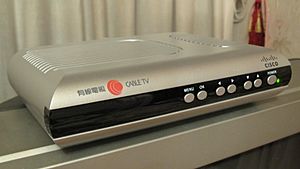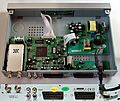Set-top box facts for kids
A set-top box is a small device that adds extra functionality to another media device, often a television. In general, there are different kinds of such devices:
- Active devices provide a signal to the TV, they do not get any feedback from the TV. Examples of such devices are video game consoles, or DVD players.
- Passive devices rely on the TV, they don't add any new functionality; they are rare, though
- Bidirectional devices provide a signal to the TV, but they also get information back. Examples for bidirectional devices are videocassette recorders.
The most important functions of a set top box are media playback (DVD, VHS videos, perhaps interacve as a game console), recording of the data received, and being able to receive data using different channels (for example Sattelite TV, TV over internet) or methods (sometimes, signals need to be decrypted first; some people want to watch digital tv on an analogue television).
Images for kids
-
A consumer Palcom DSL-350 satellite-receiver; the IF demodulation tuner is on the bottom left, and a Fujitsu MPEG decoder CPU is in the center of the board. The power supply is on the right.
See also
 In Spanish: Decodificador de televisión para niños
In Spanish: Decodificador de televisión para niños







